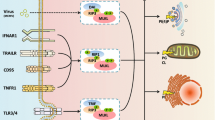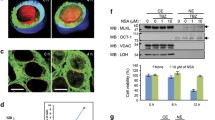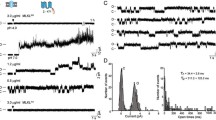Abstract
Activated receptor-interacting protein kinase 3 (RIPK3) and mixed lineage kinase domain like (MLKL) are essential components of the necroptotic pathway. Phosphorylated MLKL (pMLKL) is thought to induce membrane leakage, leading to cell swelling and disintegration of the cell membrane. However, the molecular identity of the necroptotic membrane pore remains unclear, and the role of pMLKL for membrane permeabilization is currently disputed. We observed earlier that the phospholipid scramblase and ion channel TMEM16F/anoctamin 6 cause large membrane currents, cell swelling, and cell death when activated by a strong increase in intracellular Ca2+. We, therefore, asked whether TMEM16F is also central to necroptotic cell death and other cellular events during necroptosis. Necroptosis was induced by TNFα, smac mimetic, and Z-VAD (TSZ) in NIH3T3 fibroblasts and the four additional cell lines HT29, 16HBE, H441, and L929. Time-dependent changes in intracellular Ca2+, cell morphology, and membrane currents were recorded. TSZ induced a small and only transient oscillatory rise in intracellular Ca2+, which was paralleled by the activation of outwardly rectifying Cl− currents, which were typical for TMEM16F/ANO6. Ca2+ oscillations were due to Ca2+ release from endoplasmic reticulum, and were independent of extracellular Ca2+. The initial TSZ-induced cell swelling was followed by cell shrinkage. Using typical channel blockers and siRNA-knockdown, the Cl− currents were shown to be due to the activation of ANO6. However, the knockdown of ANO6 or inhibitors of ANO6 did not inhibit necroptotic cell death. The present data demonstrate the activation of ANO6 during necroptosis, which, however, is not essential for cell death.





Similar content being viewed by others
References
Kunzelmann K (2016) Ion channels in regulated cell death. Cell Mol Life Sci 73(11–12):2387–2403
Lang F, Hoffmann EK (2012) Role of ion transport in control of apoptotic cell death. Compr Physiol 2:2037–2061
Planells-Cases R, Lutter D, Guyader C, Gerhards NM, Ullrich F, Elger DA, Kucukosmanoglu A, Xu G, Voss FK, Reincke SM, Stauber T, Blomen VA, Vis DJ, Wessels LF, Brummelkamp TR, Borst P, Rottenberg S, Jentsch TJ (2015) Subunit composition of VRAC channels determines substrate specificity and cellular resistance to Pt-based anti-cancer drugs. EMBO J 34:2993–3008
Voss FK, Ullrich F, Munch J, Lazarow K, Lutter D, Mah N, Andrade-Navarro MA, von Kries JP, Stauber T, Jentsch TJ (2014) Identification of LRRC8 heteromers as an essential component of the volume-regulated anion channel VRAC. Science 344:634–638
Qiu Z, Dubin AE, Mathur J, Tu B, Reddy K, Miraglia LJ, Reinhardt J, Orth AP, Patapoutian A (2014) SWELL1, a plasma membrane protein, is an essential component of volume-regulated anion channel. Cell 157:447–458
Linkermann A, Green DR (2014) Necroptosis. N Engl J Med 370:455–465
Chen X, Li W, Ren J, Huang D, He WT, Song Y, Yang C, Li W, Zheng X, Chen P, Han J (2014) Translocation of mixed lineage kinase domain-like protein to plasma membrane leads to necrotic cell death. Cell Res 24:105–121
Ousingsawat J, Wanitchakool P, Kmit A, Romao AM, Jantarajit W, Schreiber S, Kunzelmann K (2015) Anoctamin 6 mediates effects essential for innate immunity downstream of P2X7-receptors in macrophages. Nat Commun 6:6245
Tian Y, Schreiber R, Kunzelmann K (2012) Anoctamins are a family of Ca2+ activated Cl− channels. J Cell Sci 125:4991–4998
Yu K, Whitlock JM, Lee K, Ortlund EA, Yuan CY, Hartzell HC (2015) Identification of a lipid scrambling domain in ANO6/TMEM16F. Elife. doi:10.7554/eLife.06901
Tait SW, Oberst A, Quarato G, Milasta S, Haller M, Wang R, Karvela M, Ichim G, Yatim N, Albert ML, Kidd G, Wakefield R, Frase S, Krautwald S, Linkermann A, Green DR (2013) Widespread mitochondrial depletion via mitophagy does not compromise necroptosis. Cell Rep 5:878–885
Depeursinge C, Colomb T, Emery Y, Kuhn J, Charriere F, Rappaz B, Marquet P (2007) Digital holographic microscopy applied to life sciences. Conf Proc IEEE Eng Med Biol Soc 2007:6244–6247
Marquet P, Depeursinge C, Magistretti PJ (2013) Exploring neural cell dynamics with digital holographic microscopy. Annu Rev Biomed Eng 15:407–431
Molder A, Sebesta M, Gustafsson M, Gisselson L, Wingren AG, Alm K (2008) Non-invasive, label-free cell counting and quantitative analysis of adherent cells using digital holography. J Microsc 232:240–247
Okada Y (2006) Cell volume-sensitive chloride channels: phenotypic properties and molecular identity. Contrib Nephrol 152:9–24
Cai Z, Jitkaew S, Zhao J, Chiang HC, Choksi S, Liu J, Ward Y, Wu LG, Liu ZG (2014) Plasma membrane translocation of trimerized MLKL protein is required for TNF-induced necroptosis. Nat Cell Biol 16:55–65
Wanitchakool P, Ousingsawat J, Sirianant L, MacAulay N, Schreiber R, Kunzelmann K (2016) Cl− channels in apoptosis. Eur Biophys J. doi:10.1007/s00249-016-1140-3
Kunzelmann K, Tian Y, Martins JR, Faria D, Kongsuphol P, Ousingsawat J, Thevenod F, Roussa E, Rock JR, Schreiber R (2011) Anoctamins. Pflugers Arch 462:195–208
Namkung W, Thiagarajah JR, Phuan PW, Verkman AS (2010) Inhibition of Ca2+ -activated Cl− channels by gallotannins as a possible molecular basis for health benefits of red wine and green tea. FASEB J 24:4178–4186
Ko EA, Jin BJ, Namkung W, Ma T, Thiagarajah JR, Verkman AS (2013) Chloride channel inhibition by a red wine extract and a synthetic small molecule prevents rotaviral secretory diarrhoea in neonatal mice. Gut 63(7):1120–1129
Suzuki J, Umeda M, Sims PJ, Nagata S (2010) Calcium-dependent phospholipid scrambling by TMEM16F. Nature 468:834–838
Grubb S, Poulsen KA, Juul CA, Kyed T, Klausen TK, Larsen EH, Hoffmann EK (2013) TMEM16F (Anoctamin 6), an anion channel of delayed Ca2+ activation. J Gen Physiol 141:585–600
Shimizu T, Iehara T, Sato K, Fujii T, Sakai H, Okada Y (2013) TMEM16F is a component of a Ca2+ -activated Cl− channel but not a volume-sensitive outwardly rectifying Cl− channel. Am J Physiol Cell Physiol 304:C748–C759
Sirianant L, Ousingsawat J, Wanitchakool P, Schreiber R, Kunzelmann K (2015) Cellular volume regulation by anoctamin 6:Ca2+, phospholipase A2, osmosensing. Pflügers Arch 468:335–349
Kunzelmann K, Nilius B, Owsianik G, Schreiber R, Ousingsawat J, Sirianant L, Wanitchakool P, Bevers EM, Heemskerk JW (2014) Molecular functions of anoctamin 6 (TMEM16F): a chloride channel, cation channel or phospholipid scramblase? Pflügers Arch 466:407–414
Mattheij NJ, Braun A, van Kruchten R, Castoldi E, Pircher J, Baaten CC, Wulling M, Kuijpers MJ, Kohler R, Poole AW, Schreiber R, Vortkamp A, Collins PW, Nieswandt B, Kunzelmann K, Cosemans JM, Heemskerk JW (2015) Survival protein anoctamin-6 controls multiple platelet responses including phospholipid scrambling, swelling, and protein cleavage. FASEB J 30:727–737
Liu G, Liu G, Chen H, Borst O, Gawaz M, Vortkamp A, Schreiber R, Kunzelmann K, Lang F (2015) Involvement of Ca2+ activated Cl− channel Ano6 in platelet activation and apoptosis. Cell Physiol Biochem 37:1934–1944
Hammer C, Wanitchakool P, Sirianant L, Papiol S, Monnheimer M, Faria D, Ousingsawat J, Schramek N, Schmitt C, Margos G, Michel A, Kraiczy P, Pawlita M, Schreiber R, Schulz TF, Fingerle V, Tumani H, Ehrenreich H, Kunzelmann K (2015) A coding variant of ANO10, affecting volume regulation of macrophages, is associated with Borrelia seropositivity. Mol Med 21:26–37
Karch J, Kanisicak O, Brody MJ, Sargent MA, Michael DM, Molkentin JD (2015) Necroptosis interfaces with MOMP and the MPTP in mediating cell death. PLoS One 10:e0130520
Henriquez M, Armisen R, Stutzin A, Quest AF (2008) Cell death by necrosis, a regulated way to go. Curr Mol Med 8:187–206
Segawa K, Nagata S (2015) An apoptotic ‘eat me’ signal: phosphatidylserine exposure. Trends Cell Biol 25:639–650
Hayslett JP, Gögelein H, Kunzelmann K, Greger R (1987) Characteristics of apical chloride channels in human colon cells (HT29). Pflügers Arch 410:487–494
Kunzelmann K, Koslowsky T, Gruenert DC, Greger R (1994) CAMP-dependent activation of ion conductances in bronchial epithelial cells. Pflügers Arch 428:590–596
Faria D, Lentze N, Almaca J, Luz S, Alessio L, Tian Y, Martins JP, Cruz P, Schreiber R, Rezwan M, Farinha CM, Auerbach D, Amaral MD, Kunzelmann K (2012) Regulation of ENaC biogenesis by the stress response protein SERP1. Pflugers Arch 463:819–827
Linkermann A, Brasen JH, De Zen F, Weinlich R, Schwendener RA, Green DR, Kunzendorf U, Krautwald S (2012) Dichotomy between RIP1- and RIP3-mediated necroptosis in tumor necrosis factor-alpha-induced shock. Mol Med 18:577–586 (Cambridge, Mass)
Schreiber R, Uliyakina I, Kongsuphol P, Warth R, Mirza M, Martins JR, Kunzelmann K (2010) Expression and Function of Epithelial Anoctamins. J Biol Chem 285:7838–7845
Acknowledgments
This work was supported by DFG SFB699-A7/A12, DFG KU756/12-1, Volkswagenstiftung AZ 87 499, and Medical Faculty of Kiel University (F355910 to SK).
Author information
Authors and Affiliations
Corresponding author
Electronic supplementary material
Below is the link to the electronic supplementary material.
Rights and permissions
About this article
Cite this article
Ousingsawat, J., Cabrita, I., Wanitchakool, P. et al. Ca2+ signals, cell membrane disintegration, and activation of TMEM16F during necroptosis. Cell. Mol. Life Sci. 74, 173–181 (2017). https://doi.org/10.1007/s00018-016-2338-3
Received:
Revised:
Accepted:
Published:
Issue Date:
DOI: https://doi.org/10.1007/s00018-016-2338-3




